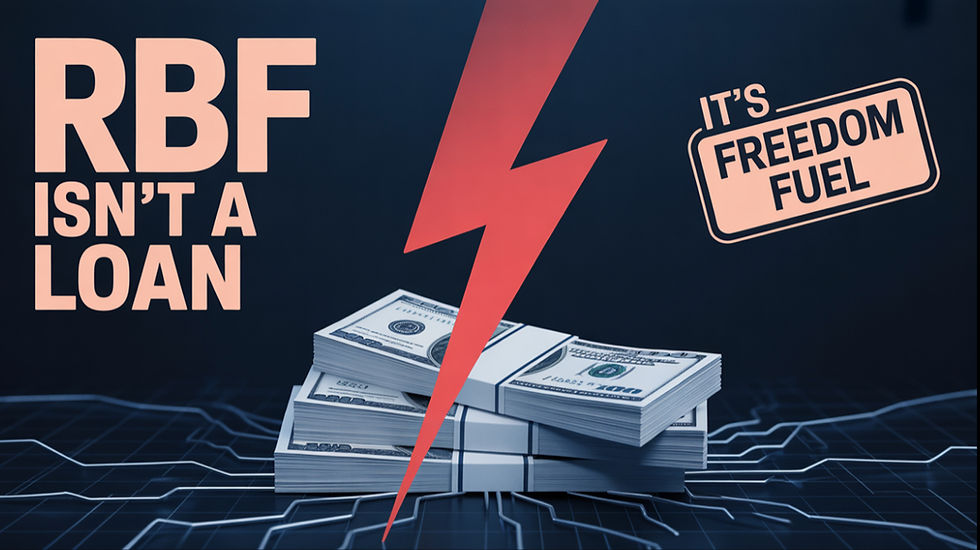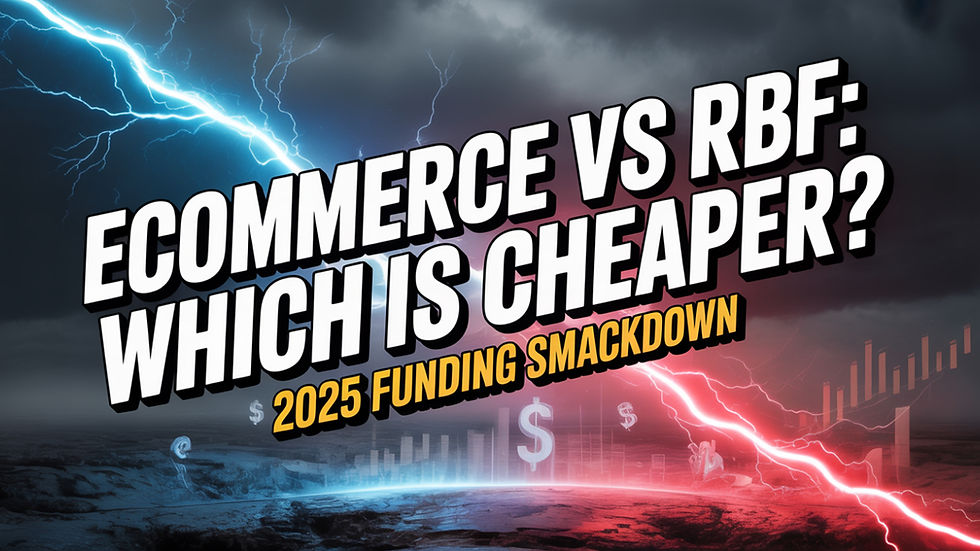Revenue‑Based Financing Myths Debunked
- Jason Feimster
- Aug 25
- 11 min read
Think revenue-based financing is just a loan in disguise? Think again. This myth-busting guide exposes outdated beliefs and shows SaaS & DTC founders why RBF is the fastest, fairest, and most founder-friendly way to scale—without dilution, drama, or delay.
🚀 Introduction
“You Didn’t Build Your Company Just to Hand It Over.”
You’ve bootstrapped, bargained, and broken through every ceiling just to get here.
You’ve survived launch chaos, scaled through supply chain nightmares or churn hell, and now… you’re staring down the same question that haunts every growing founder:
How do I fund the next leap—without giving away the soul of my business?
Venture capital says, “We’ll take 30% and tell you how to run things.”
Traditional loans say, “Collateral or bust.”
But somewhere in the noise, a smarter, quieter alternative has been labeled a “plan B”...
And that label? Flat-out wrong.
This post is your myth-busting, equity-saving, growth-liberating manifesto.We’re ripping apart the most toxic myths surrounding revenue-based financing — the same myths that have kept founders like you shackled to outdated funding models.
Because here’s the truth no one’s screaming loud enough:
🧨 RBF isn’t just an option — it might be the most founder-friendly form of capital on the planet.
Let’s debunk the lies.
Let’s take your power back.
Let’s fund your next move — on your terms.
💣 Myth #1: “Revenue-Based Financing is Just a Fancy Loan”
Let’s get something straight: revenue-based financing (RBF) is not a loan wearing lipstick.
If you've been told it's “just debt with marketing,” you've been misled by people still playing by the old rules.
Here’s the difference that changes everything:
🌀 Loans are rigid. RBF is fluid.
Traditional loans demand the same monthly payment—whether your revenue soars or tanks. You pay—or you face penalties, damaged credit, even personal liability.
But RBF?
It moves with you.
You pay a fixed percentage of your monthly revenue—no revenue = no repayment.
There’s no compounding interest breathing down your neck.
No personal guarantees chaining your home or assets to your company’s ups and downs.
📉 Had a slow quarter? You pay less.
📈 Hit a growth spurt? You pay a little more—but still in proportion.
That’s not a loan. That’s alignment.
It’s capital that flexes with your business, not against it. And it’s built for founders who understand that cash flow isn’t predictable—but ambition always is.
“I’d rather have capital that adapts to my journey than one that punishes my volatility.” — every smart SaaS or DTC founder ever (or soon to be)
So no, revenue-based financing isn’t just a loan in disguise. It’s what funding should’ve always been—fair, flexible, and founder-focused.
💣 Myth #2: “You Can’t Raise Big Money with RBF”
Somewhere along the startup grapevine, this myth took root:
“Revenue-based financing is fine for a quick $50K bridge—but if you need real capital, go VC or go home.”
Let’s burn that lie to the ground.
Here’s the truth: RBF isn’t pocket change.
It ’s growth-stage fuel — and serious players are using it to raise $500K, $1M, even $5M+ to scale faster than ever.
Especially in SaaS and DTC, where predictable revenue meets strong margins, RBF providers are actively competing to fund aggressive growth moves like:
Scaling paid acquisition
Launching new product lines
Expanding to new markets
Pre-purchasing inventory at bulk rates
And guess what?
Unlike equity rounds, you’re not waiting 3–6 months for a yes. With RBF, funding decisions often land in days, not quarters.
💡 Founders Are Already Winning with Big RBF
7-figure Shopify brand? RBF funded their Q4 inventory and Black Friday ads—no equity given.
B2B SaaS at $150K MRR? RBF covered their entire SDR team expansion—without a single board seat handed out.
If the capital’s big enough to fund your next growth leap, does it matter if a VC signs off on it?
What matters is this:
✅ You keep ownership.
✅ You move fast.
✅ You don’t wait for permission.
So no, RBF isn’t small-time capital. It ’s big-time money for founders with a big-time plan—and the courage to keep control.
💣 Myth #3: “RBF Is Only for Failing or Desperate Businesses”
Let’s call this out for what it really is: startup snobbery.
Somewhere in the VC echo chamber, this narrative took hold:
“If you're not raising equity, you must be struggling.”
That’s not just wrong—it’s dangerously outdated.
Here’s the truth:
🧠 Smart, cash-flow-positive, high-margin businesses are choosing RBF—not because they’re desperate, but because they’re done playing the startup casino.
They don’t want to pitch for months. They don’t want to hand over control.
And they definitely don’t want to lose 20% of their company for a check that barely covers next quarter’s ad spend.
📈 The New Breed of Founder Chooses RBF Strategically:
A bootstrapped SaaS founder with $80K MRR used RBF to launch a new feature faster—while keeping 100% equity intact.
A DTC skincare brand scaled their influencer program via RBF and hit 3X ROAS within 90 days—no board approval required.
These aren’t failing businesses.
These are disciplined, data-driven, profitable machines choosing funding that matches their mindset.
“I didn’t want to raise equity because I wasn’t desperate. I was just ready to win faster—on my own terms.”
That’s what revenue-based financing represents now:
⚡ Capital without the compromise.
🚀 Speed without the politics.
👑 Growth without the loss of sovereignty.
So the next time someone implies RBF is for the weak?
Smile. Then show them your margins and your cap table.
💣 Myth #4: “You Lose More With RBF in the Long Run”
This one sounds logical at first—until you dig into the numbers.
The narrative goes:
“RBF might feel cheaper now, but over time, you’ll repay more than you would with equity. So really, it’s more expensive.”
Let’s unpack that with clarity—and a cold splash of truth.
🧮 Equity Costs More Than Money. It Costs You Your Company.
Sure, an investor might write you a $1M check today for 20% of your business. You feel “funded.” You feel seen. But flash forward 5 years—your company’s doing $20M ARR, maybe even more.
That 20% you gave away?
Now worth $10M. Maybe $15M. And they’re still calling shots.
Now let’s flip it.
That same $1M via RBF? You might repay $1.2M to $1.4M total. No board seat. No voting rights. No equity given. No regrets.
📊 RBF vs Equity – The Real ROI:
Funding Type | Capital Raised | Founder Equity After | Total Repayment | Long-Term Cost |
|---|---|---|---|---|
Equity | $1M | 80% (down from 100%) | None (but 20% exit) | $10M+ in equity |
RBF | $1M | 100% | ~$1.3M total | $300K max |
Let that sink in.
💡 RBF Gives You Capital. Equity Takes Your Legacy.
And don’t forget:
RBF is fast. (Days, not months)
RBF is clean. (No dilution, no hidden claws)
RBF is founder-first. (You call the shots)
“I’d rather pay back money than permanently lose control of my life's work.”
So no—RBF doesn’t cost you more in the long run.
Equity does. In ownership. In options. In exit potential.
Choose wisely. Because you’re not just funding your business—you’re defending your future.
⚡ Why RBF Is the New Power Move for SaaS & DTC Founders
This isn’t just a funding model. It’s a mindset shift. It’s founders everywhere saying:
“I don’t need to ask permission to grow anymore.”
Because here’s what revenue-based financing really unlocks:
🔓 1. Zero Dilution = 100% Ownership
You keep your cap table clean, your vision intact, and your strategic freedom untouched. No monthly investor updates. No surprise term sheets. Just pure autonomy.
🕰️ 2. Speed that Matches Startup Life
You’re not building on a 6-month VC timeline.
You need cash this quarter, not “after due diligence.”
With RBF, you can get funded in as little as 3–7 days.
That’s game-changing agility.
🔁 3. Repay from Revenue, Not Stress
You’re not draining your bank account on fixed loan payments.
You repay only when revenue flows—scaling repayment to success, not stress.
🎯 4. Fuel Strategic Moves Without Sacrifice
Use RBF to double down on what works:
📦 Bulk inventory purchases ahead of peak seasons
📈 Scalable ad spend with immediate ROAS
🧠 Hiring key team members now, not “after the round closes”
💥 5. You Become Unstoppable
The real power isn’t just the money. It’s the confidence to say:
“I don’t need a VC’s approval.”
“I don’t need to give up control.”
“I fund growth on my terms.”
RBF isn’t the fallback plan. It’s the founder’s first-class upgrade.
So if you’re a SaaS or DTC founder with revenue and vision—but sick of the old funding traps—RBF is your move.
No strings. No suits. Just speed, scale, and sovereignty.
🛠️ Step-by-Step: How to Know if RBF Is Right for You
Revenue-Based Financing isn’t for everyone. And that’s exactly why it’s powerful. It’s not blanket capital. It’s precision funding—for the bold, the focused, the ready.
Here’s how to know if RBF fits your business like a glove:
✅ Step 1: You’ve Got Revenue That Repeats
If your cash register doesn’t ring predictably, RBF won't work.
But if you’ve got:
SaaS MRR or ARR that’s sticky
DTC product sales with solid velocity
Repeat purchase behavior or subscriptions
...you’ve already passed the first filter.
✅ Step 2: You Have High Margins
RBF thrives when you do. If your margins are 30% or higher, you can comfortably share a slice of revenue without starving your ops.
Ask yourself:
Can I afford to give up 5–10% of top-line revenue for 6–12 months?
Will that capital return at least 2–3X?
If yes, RBF just became your best friend.
✅ Step 3: You Want Speed, Not Drama
RBF providers typically fund you within days, not months. No pitch decks, no round coordination, no egos. Just clean capital and go.
This is ideal if you're:
Scaling fast and need a growth runway now
Capitalizing on seasonal demand or limited-time market windows
Launching paid campaigns with proven CAC:LTV
✅ Step 4: You Refuse to Give Up Control
You didn’t build your brand to hand over your vision.
RBF lets you keep your board, your brand voice, your decision-making—and your sleep.
If control is sacred, RBF is your armor.
✅ Step 5: You’ve Got a Plan
Don’t take capital just because it’s available. Take it because it multiplies what already works.
You should know:
What you’ll use the funding for (ads, inventory, product dev)
What ROI you expect (ROAS, CAC reduction, conversion lift)
How repayment fits into your cash flow model
RBF amplifies clarity. Not chaos.
If you’re nodding along to 3 or more of these—congrats.
You’re RBF-ready. And you might be sitting on the most founder-friendly funding route of the decade.
📊 ROI Breakdown: RBF vs Equity vs Loans
Follow the Money. Find the Freedom.
It’s easy to get emotionally swept up in a VC term sheet or a bank’s low-interest offer.But numbers don’t lie—and neither does long-term cost.
Here’s how Revenue-Based Financing stacks up against the usual suspects:
🧾 Option 1: Traditional Bank Loan
Repayment: Fixed monthly, regardless of revenue
Interest: Compounding
Speed: Slow (weeks to months)
Collateral: Often required
Control: You keep it—but under stress
Hidden Pain: Fixed payments crush you in slow months, and banks don’t care.
🏢 Option 2: Equity (Angel or VC)
Repayment: None… but you’ve sold ownership
Dilution: Permanent
Speed: Months of pitching, due diligence, and terms
Control: Shared (or lost entirely)
Upside: Big if you exit—if you’re lucky
Hidden Pain: That 20–30% equity you gave away?
Could be worth millions down the line—gone forever.
🚀 Option 3: Revenue-Based Financing
Repayment: Variable % of monthly revenue
Total Cost: Fixed multiple (e.g., $100K → repay $120K–$140K)
Speed: Fast (often <10 days)
Collateral: None
Control: 100% remains with you
Hidden Strength: It scales with your cash flow.
No equity lost. No control sacrificed. No stress added.
💰 Real-World Comparison Table
Funding Type | Speed | Ownership | Repayment Risk | Long-Term Cost | Best For |
|---|---|---|---|---|---|
Bank Loan | Slow | ✅ Yes | ❌ High | 💸 Moderate | Risk-averse, asset-backed businesses |
Equity | Very Slow | ❌ Lost % | ✅ None | 💰 Massive (in exits) | High-risk, hyper-growth plays |
RBF | ⚡ Fast | ✅ 100% Yours | ✅ Scaled | 💡 Predictable | SaaS & DTC founders with traction |
“Equity takes your upside. Loans take your stability. RBF lets you keep both.”
If you value agility, ownership, and ROI clarity—you already know who wins this comparison.
⚠️ Pitfalls to Avoid with RBF
Smart money still needs smart decisions.
Revenue-Based Financing is powerful—but like any tool, it can cut both ways if you’re not intentional.
Here’s how to dodge the most common traps founders fall into when using RBF:
❌ 1. Taking More Than You Need
RBF isn’t “free money.” The more you take, the more you repay. Simple.
Don’t raise a $500K facility just because it’s available—raise what you can strategically deploy with confidence.
Ask yourself:
Will this capital 2X or 3X my output?
Do I have a plan or just a hunch?
❌ 2. Misaligning Repayment with Cash Flow
Most RBF deals take 5–15% of revenue monthly.
If your margins are tight or sales fluctuate wildly, be careful not to choke your own runway.
Pro move:
Negotiate terms that flex with seasonality or campaign cycles.
Align RBF repayment with your actual revenue rhythms.
❌ 3. Ignoring the Fine Print
Not all RBF providers are created equal.
Watch for:
Sneaky fees or origination charges
Accelerated repayment clauses
Vague definitions of “revenue”
Pro move:
Treat RBF contracts like you would a term sheet: read them line by line.
If it’s not founder-first, walk.
❌ 4. Using RBF for Unproven Bets
RBF works best when you’re doubling down on what already converts.
Do not use it to:
Launch untested products
Hire experimental roles
Gamble on a brand pivot
Use it to scale what works, not discover what doesn’t.
“RBF is like jet fuel—it’ll get you there faster, but only if you know where you’re going.”
Use it wisely. Scale with intention. Protect your upside.
❓ FAQ: The Real Talk on Revenue-Based Financing Myths
Clear answers. No fluff. Just founder truths.
🤔 Is revenue-based financing safe?
Yes—as safe as your terms.
RBF isn’t predatory lending. When done right, it’s built to align with your success, not punish your pressure points.
Just make sure:
You understand the payback multiple
The repayment % works with your margins
There are no sneaky clauses hiding in fine print
If you’re informed, RBF is one of the most transparent and founder-aligned options out there.
⏱️ How fast can I get funded with RBF?
Fast. Like 3–10 business days fast.
Most RBF providers require:
Access to your Stripe or Shopify data
Basic P&L / cash flow statements
A clear use-of-funds plan
You don’t need to build a pitch deck.
You don’t need to charm a partner meeting. You just need a solid business with predictable revenue.
📉 Does revenue-based financing hurt my valuation?
Nope. In fact, it protects it.
Unlike equity, RBF doesn’t touch your cap table.
You keep full ownership. Which means when you're ready for a valuation—whether from a VC, acquirer, or even private equity—you haven’t diluted your shares or leverage.
Smart founders use RBF to hit milestones that increase valuation—without losing any of it.
🔄 Can I stack RBF with other funding?
Absolutely.
RBF plays well with others. Many founders combine it with:
Equity rounds (to reduce dilution)
Grants or credits
Traditional loans (with better terms after de-risking growth)
Use RBF to extend runway, boost valuation, and fund non-dilutive growth—then raise equity from a position of strength.
💡 What types of businesses qualify for RBF?
You’re a great fit if:
You're a SaaS brand with >$20K MRR
You're a DTC brand with $50K+ monthly sales
You have strong gross margins (30%+ recommended)
You’ve got predictable revenue and low churn
You’re hungry to grow—on your terms
“RBF is for the smart, the steady, and the scaling—not the struggling.”
It’s not a bailout. It’s a slingshot for founders who know where they’re going.
🔚 Conclusion: Your Company, Your Control
You Built This. Don’t Hand It Over.
You didn’t bootstrap through sleepless nights and near-burnout weekends just to give away your company for a lifeline.
You built something real.
Something that generates revenue.
Something that deserves respectful, flexible, founder-first capital.
And yet, the old myths—about RBF being weak, small, or dangerous—have scared too many great founders into giving up too much, too soon.
Here’s what we’ve uncovered:
RBF isn’t a loan in disguise—it’s a growth-aligned tool
It’s not small money—it’s scalable and smart
It’s not for failures—it’s used by sharp, high-margin winners
It doesn’t cost you more long-term—equity does
It’s not risky when used wisely—it’s empowering
So now the choice is yours.
You can chase validation.
Or you can claim control.
You can dilute your future.
Or you can fund it without compromise.
Because at the end of the day, your company should work for you—not the other way around.
Revenue-Based Financing isn’t just an option. It’s a revolution. And it’s yours to use.
🚀 Ready to Fund Your Growth—Without Giving Up Control?
You’ve read the myths. You’ve seen the numbers. You feel the fire in your gut that says:
“I want capital that respects my vision.”
If you’re a founder with revenue, margins, and momentum—you don’t need to give up equity or beg for permission.
You need a smarter path.
A founder-first path. You need Revenue-Based Financing that works for you.
⚡ 5 minutes.
🔒 No commitments.
🎯 Just clarity on what you could unlock—on your terms.
It’s your move. Own it.







Comments